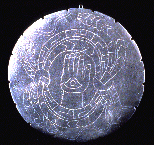| Environment | Technology | Settlement | Economy | Society | Health | Religion | Art |
| How-Do-We-Know? | |||||||
| Paleo-Indian | Archaic | Woodland | Mississippian | European Contact |

 Animals, plants, and other aspects of the natural environment in the American Bottom assumed special importance and roles in the spiritual life of Native Americans. Believing that all things are related, many historic Native American groups had beliefs and rituals that likely had counterparts in the spiritual lives of Mississippians: They prayed to the spirits of the game they hunted for foregiveness for taking their lives.
Animals, plants, and other aspects of the natural environment in the American Bottom assumed special importance and roles in the spiritual life of Native Americans. Believing that all things are related, many historic Native American groups had beliefs and rituals that likely had counterparts in the spiritual lives of Mississippians: They prayed to the spirits of the game they hunted for foregiveness for taking their lives.
The importance of wetlands in the Mississippian world view is likely reflected in the frequent use of frogs, turtles, ducks and other aquatic animals as decorative motifs on pipes, bowls, and ornamental items. Animals that moved between different environments - land, water, or sky might be viewed as mediators or messengers between people and the spirit worlds above and below the earth. The long-lived cedar tree, with its durable red wood and pleasant scent, has spiritual importance to many American Indian groups. Its wood and boughs are often used to purify and sanctify. Numerous burial litter poles from Mound 72 at Cahokia are made of cedar.
Spanish accounts of the Natchez in Mississippi provide some clues about the religious activities of Mississippian priests. Ceremonies and rituals led by priests and chiefs to mark the passing of the seasons, celestial events, and harvesting of crops took place on top of the flat-topped mounds while the common people observed in the plazas at the base of the mounds.
| Paleo-Indian | Archaic | Woodland | Mississippian | European Contact |